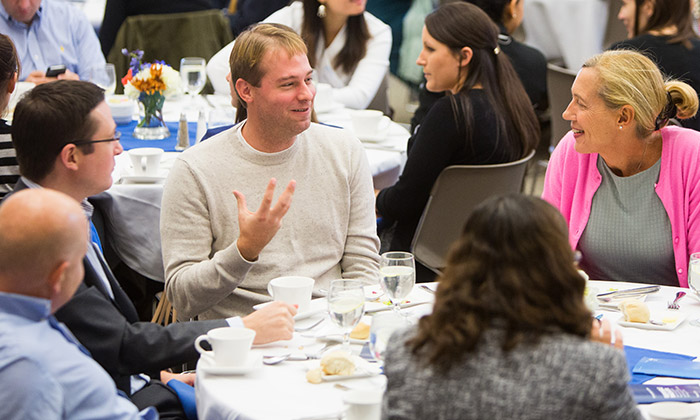
Bentley’s Thought Leadership Networks Increase Scholarly Collaboration
“Research across boundaries.”
That serves as the call to action for Bentley’s new Thought Leadership Networks, funded as a pilot initiative in the 2014-2015 academic year and now entering the next stage of development.
Any individual scholar or discipline might unwittingly approach a complex issue in a parochial manner. These new networks engage a multidisciplinary group of scholars and thought leaders, pushing all to take a broad-based approach and wider view.
This was the vision and hope of Provost and Vice President for Academic Affairs Mike Page, last year, when he authorized the Faculty Research Council to offer up to $90,000 in funding for “exploratory” Thought Leadership Network (TLN) proposals and up to $140,00 for each of the next five years to establish and develop these networks. Page had seen an organic growth in trans-disciplinary research at Bentley in recent years and wanted to harness and support that development in a systematic way. Another goal was expanding faculty partnerships with colleagues at other institutions and with thought leaders in business and other fields.
As TLN Subcommittee chair Dhaval Dave puts it, the networks are “the perfect logical extension of what Bentley is and what it stands for: We’re known as a business fusion university, training students in trans-disciplinary perspectives and knowledge. The TLNs will capitalize on that identity and push it forward in a broad stroke.”
According to Dave, the Stanton Research Professor of Economics, TLNs have the same spirit and intent as initiatives usually funded by much larger institutions. Entities such as the National Institutes of Health, National Science Foundation and National Endowment for the Humanities routinely create multidisciplinary, collaborative, coordinated scholarly networks to study an expansive research question or questions on related topics.
Twelve applications were submitted to the first call for proposals; eight TLNs were awarded “Phase I” status at an average of over $13,000 for each of the seven networks that sought financial support (one networks requested in-kind support but no funds at this initial stage).
In Phase I, the networks created the virtual infrastructure necessary to support research into the chosen questions. The focus was on convening research conversations, identifying priorities and opportunities, and clarifying next steps – essentially mapping the scholarly landscape for the questions at hand.
Dave and other professors at Bentley report widespread interest and excitement across the institution in response to the call for proposals in spring 2014. They characterize the summer months—which can be periods of relatively isolated work for faculty—as deeply and energetically collaborative as the TLNs received approvals and moved into development stage.
The TLNs approved in the first round focus on:
- Adapting to the changing health care landscape
- Developing undergraduate/faculty research collaborations at Bentley
- Expanding science, technology, engineering, and mathematics (STEM) education across the business curriculum
- Cybersecurity
- Exploring the creation of a data analytics center at Bentley University
- Researching the methods and algorithms of data analytics
- Data-driven decision making, innovation, and value creation
- Examining how public agencies use data analytics/big data
(These last four TLNS, to unlock synergies, merged into one larger TLN in the second round.)
TLNs are broader than any single research project or approach, and need not consist only—or even primarily—of Bentley faculty. Participants to date include representatives from Pfizer, Harvard School of Public Health, IBM, public safety agencies, and others. The health care TLN, for example, held a research retreat for Bentley faculty, faculty from other institutions, and other relevant thought leaders in both the public and private sectors. A new TLN in the second round on “smart cities” research would have similarly broad-reaching impact and appeal.
Moving into Phase II the TLNs will answer some critical questions:
- Did they map the research landscape as planned in Phase I?
- What are the most critical research priorities of this topic?
- What infrastructure is needed — in either virtual or actual terms — to pursue these research questions?
- What external funding or business models exist to allow this TLN to become self-sustaining over time?
- What are the deliverables of this TLN?
- What will be the network’s relevance and impact?
Both Dave and Page report that the TLNs are a welcome conduit for trans-disciplinary scholarship. They have helped reshape and reinvigorate conversations taking place in faculty hallways on how to bring scholars and other thought leaders together.
Over time, some TLNs may run their logical courses, others may emerge as virtual centers of scholarship on a given topic, and still others may become actual research centers at the university. In all cases, TLNs are meant to convene some of the most important research conversations of our day, and to help put Bentley on the map as a leader in such efforts.
Such high-flown endpoints may start from modest roots. A handful of faculty meets over coffee to update each other on research initiatives, only to discover a network in their midst.
“As an economics professor, I get to invoke the cliché about each TLN creating a whole that is greater than the sum of its parts,” says Dave. “That’s some of the excitement about this effort here at Bentley. There’s really no telling how far some of these efforts can grow.”

